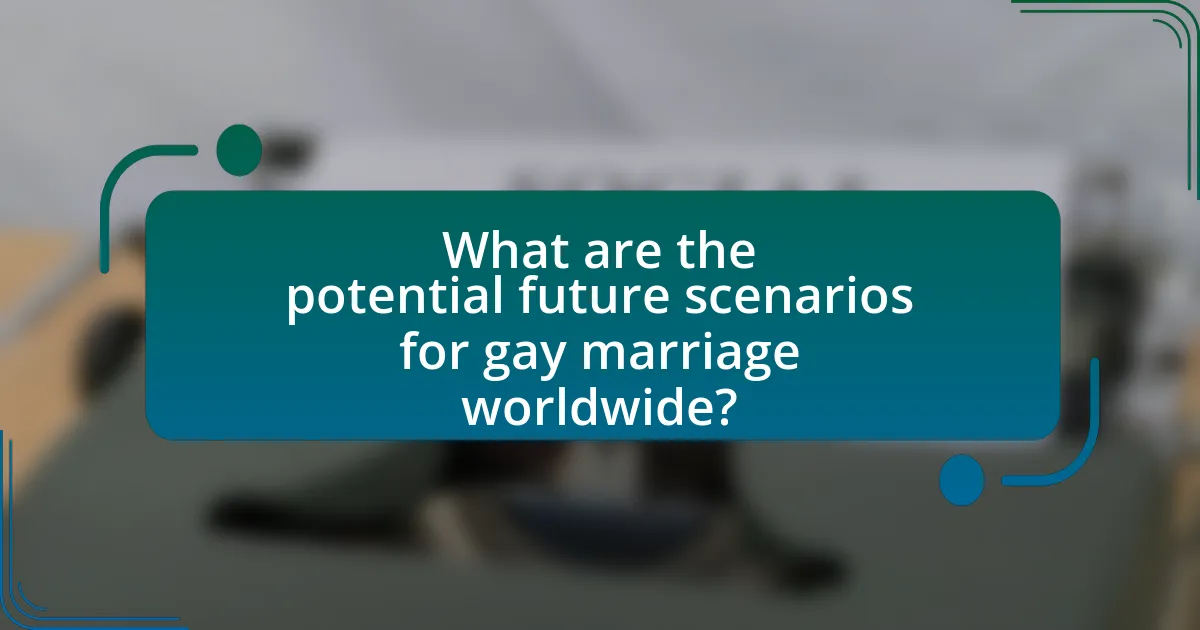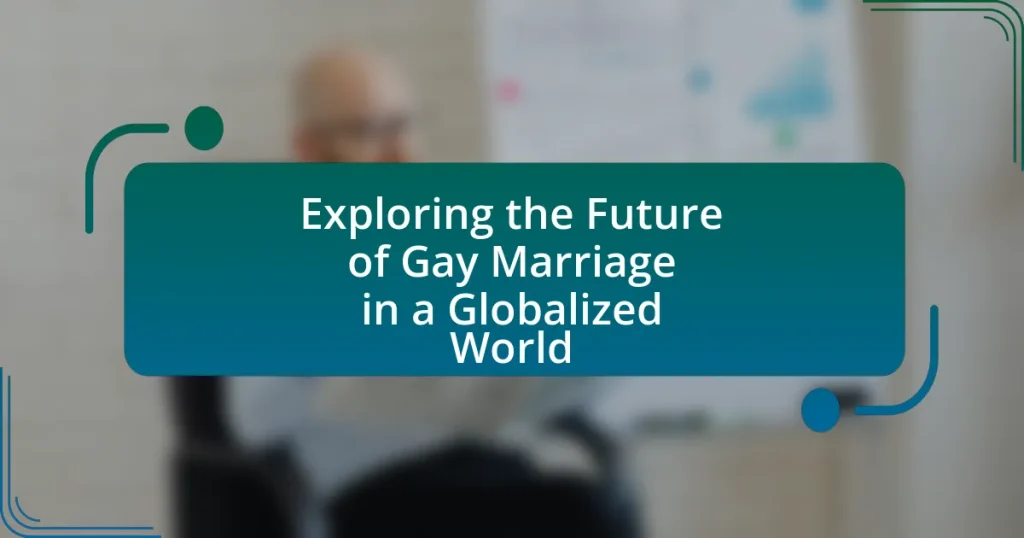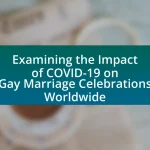The article examines the current state and future of gay marriage globally, highlighting that as of October 2023, 34 countries legally recognize same-sex marriage, with significant disparities in acceptance across regions. It discusses the varying legal frameworks, cultural attitudes, and challenges faced by same-sex couples, particularly in areas where gay marriage is not recognized. The piece also explores the influence of globalization, political movements, and media representation on the acceptance of gay marriage, while identifying emerging trends in public opinion and potential future scenarios for LGBTQ+ rights. Additionally, it outlines effective advocacy strategies and resources available for individuals seeking to understand gay marriage rights.

What is the current state of gay marriage globally?
As of October 2023, gay marriage is legally recognized in 34 countries worldwide, including the United States, Canada, and most Western European nations. This recognition reflects a growing acceptance of LGBTQ+ rights, with countries like Taiwan becoming the first in Asia to legalize same-sex marriage in 2019. However, many regions, particularly in Africa and the Middle East, still have laws that criminalize same-sex relationships, indicating a significant disparity in the global landscape. The increasing number of countries legalizing gay marriage demonstrates a trend towards greater equality, but challenges remain in areas where LGBTQ+ rights are not protected.
How have different countries approached the legalization of gay marriage?
Different countries have approached the legalization of gay marriage through various legal frameworks and societal attitudes. For instance, the Netherlands became the first country to legalize same-sex marriage in 2001, setting a precedent that many nations followed. In contrast, countries like the United States have seen a patchwork of legalization, with the Supreme Court ruling in Obergefell v. Hodges (2015) that same-sex marriage is a constitutional right, while other nations, such as Russia, have enacted laws that actively oppose it, reflecting a more conservative stance. Additionally, countries like Germany and Australia legalized gay marriage in 2017 and 2017 respectively, showcasing a trend towards acceptance in many Western democracies. In contrast, several African and Middle Eastern countries maintain strict prohibitions against same-sex relationships, illustrating the diverse global landscape regarding this issue.
What are the legal frameworks supporting gay marriage in various nations?
Legal frameworks supporting gay marriage vary significantly across nations, with some countries enacting comprehensive laws while others maintain prohibitive measures. For instance, in the United States, the Supreme Court’s decision in Obergefell v. Hodges (2015) legalized same-sex marriage nationwide, affirming that the right to marry is a fundamental liberty protected by the Constitution. Similarly, countries like Canada and the Netherlands have established legal recognition for same-sex marriages since 2005 and 2001, respectively, through legislative acts that explicitly allow marriage between same-sex couples. In contrast, nations such as Saudi Arabia and Uganda have laws that criminalize same-sex relationships, reflecting a stark divergence in legal recognition. These frameworks illustrate the global landscape of gay marriage, highlighting both progress and resistance in various legal systems.
How do cultural attitudes influence the acceptance of gay marriage?
Cultural attitudes significantly influence the acceptance of gay marriage by shaping societal norms and values regarding sexual orientation and relationships. In societies where traditional views on marriage and family are predominant, acceptance tends to be lower, as seen in many regions of Africa and the Middle East, where legal recognition of gay marriage is often absent. Conversely, in more progressive cultures, such as those in Western Europe and North America, positive attitudes towards LGBTQ+ rights have led to increased acceptance and legal recognition of gay marriage, evidenced by the legalization of same-sex marriage in countries like the Netherlands in 2001 and the U.S. in 2015. Studies, such as those conducted by the Pew Research Center, show that public support for gay marriage correlates with factors like education level, age, and exposure to diverse cultures, indicating that cultural attitudes are pivotal in determining the legal and social acceptance of gay marriage.
What challenges do same-sex couples face in regions where gay marriage is not recognized?
Same-sex couples in regions where gay marriage is not recognized face significant legal and social challenges. These challenges include the lack of legal recognition for their relationships, which can result in difficulties accessing healthcare, inheritance rights, and tax benefits that heterosexual couples enjoy. For instance, a study by the Williams Institute found that same-sex couples in non-recognizing regions often encounter barriers in hospital visitation rights and decision-making in medical emergencies. Additionally, societal stigma and discrimination can lead to isolation and mental health issues, as same-sex couples may face hostility from their communities. This combination of legal and social obstacles severely impacts their quality of life and overall well-being.
What legal obstacles exist for same-sex couples in non-legalized countries?
Same-sex couples in non-legalized countries face significant legal obstacles, including the lack of legal recognition for their relationships, which prevents them from accessing rights and benefits afforded to heterosexual couples. These obstacles often manifest as prohibitions against marriage, adoption, and inheritance, as well as limited access to healthcare and social services. For instance, in countries like Saudi Arabia and Uganda, same-sex relationships are criminalized, leading to potential imprisonment and persecution. Additionally, societal stigma and discrimination further complicate the legal landscape, making it difficult for same-sex couples to seek legal recourse or protection.
How do social stigmas impact the lives of same-sex couples in these regions?
Social stigmas significantly impact the lives of same-sex couples in various regions by fostering discrimination, social isolation, and mental health challenges. In many societies, negative perceptions of same-sex relationships lead to legal and social barriers, such as lack of recognition for marriage or civil unions, which can result in economic disadvantages and limited access to healthcare benefits. For instance, a study by the Williams Institute found that same-sex couples in regions with high levels of stigma experience higher rates of depression and anxiety compared to their heterosexual counterparts. This stigma can also manifest in hostile environments, where same-sex couples face harassment or violence, further exacerbating their challenges and limiting their ability to participate fully in society.

What factors are influencing the future of gay marriage?
The future of gay marriage is influenced by legal, social, and political factors. Legal recognition varies significantly across countries, with some nations expanding rights while others impose restrictions; for instance, as of 2023, over 30 countries have legalized same-sex marriage, reflecting a growing acceptance. Social attitudes are shifting, particularly among younger generations, who tend to support LGBTQ+ rights more than older demographics, as evidenced by surveys indicating that over 70% of millennials in the U.S. favor marriage equality. Political movements and advocacy groups play a crucial role in shaping policies and public opinion, with organizations like Human Rights Campaign actively campaigning for equality. These combined factors create a dynamic landscape for the future of gay marriage, where progress is contingent upon ongoing advocacy, legal reforms, and societal acceptance.
How does globalization affect the acceptance of gay marriage?
Globalization positively influences the acceptance of gay marriage by promoting cultural exchange and the dissemination of progressive values. As countries become more interconnected through trade, communication, and travel, exposure to diverse perspectives on LGBTQ+ rights increases. For instance, nations that have legalized gay marriage often serve as models for others, demonstrating the social and economic benefits of inclusivity. According to a 2020 study published in the Journal of Homosexuality, countries with higher levels of globalization tend to have more favorable attitudes towards same-sex marriage, as seen in the correlation between globalization indices and public support for LGBTQ+ rights in various regions. This trend indicates that globalization acts as a catalyst for social change, fostering environments where gay marriage can be more widely accepted.
What role do international organizations play in promoting gay rights?
International organizations play a crucial role in promoting gay rights by advocating for legal protections, raising awareness, and providing resources to support LGBTQ+ communities globally. Organizations such as the United Nations and Amnesty International actively campaign for the decriminalization of homosexuality and the recognition of same-sex relationships, influencing national policies through reports and resolutions. For instance, the UN Free & Equal campaign has highlighted the discrimination faced by LGBTQ+ individuals and has mobilized support for equality initiatives in various countries, demonstrating the impact of international advocacy on local laws and societal attitudes.
How does media representation impact public perception of gay marriage?
Media representation significantly influences public perception of gay marriage by shaping societal attitudes and beliefs. Positive portrayals in television, film, and news media can normalize gay relationships, leading to increased acceptance and support for marriage equality. For instance, a study by the Williams Institute found that exposure to LGBTQ+ characters in media correlates with more favorable views on same-sex marriage among viewers. Conversely, negative or stereotypical representations can perpetuate stigma and resistance to gay marriage. Thus, the way media depicts gay marriage plays a crucial role in either advancing or hindering public acceptance.
What are the implications of changing political landscapes on gay marriage rights?
Changing political landscapes can significantly impact gay marriage rights by either advancing or restricting legal recognition and protections for same-sex couples. For instance, in countries where political parties that support LGBTQ+ rights gain power, legislation may be enacted to legalize or strengthen marriage equality, as seen in the United States with the Supreme Court’s 2015 decision in Obergefell v. Hodges, which legalized same-sex marriage nationwide. Conversely, in regions where conservative or anti-LGBTQ+ political factions gain influence, there may be efforts to roll back existing rights, such as the introduction of laws that define marriage strictly as a union between a man and a woman, which has occurred in various states and countries. These shifts can lead to increased social polarization and affect public opinion, as seen in surveys indicating that support for gay marriage often correlates with the political climate.
How do elections and political movements influence gay marriage legislation?
Elections and political movements significantly influence gay marriage legislation by shaping public policy and societal attitudes. Political parties often adopt stances on gay marriage that reflect their voter base, which can lead to legislative changes when they gain power. For instance, the election of pro-LGBTQ+ candidates has historically resulted in the introduction and passage of marriage equality laws, as seen in the United States with the 2012 election of pro-gay marriage politicians in key states. Additionally, social movements advocating for LGBTQ+ rights mobilize public support and pressure lawmakers to enact legislation, exemplified by the impact of the Marriage Equality Movement leading up to the U.S. Supreme Court’s 2015 decision in Obergefell v. Hodges, which legalized same-sex marriage nationwide. These dynamics illustrate how electoral outcomes and organized advocacy can directly alter the legal landscape for gay marriage.
What trends are emerging in public opinion regarding gay marriage?
Public opinion regarding gay marriage is increasingly supportive, with a significant majority of people in many countries now favoring legalization. For instance, a 2021 Gallup poll indicated that 70% of Americans support same-sex marriage, reflecting a steady rise from just 27% in 1996. This trend is also evident globally, as countries like Germany and Australia have recently legalized gay marriage, influenced by shifting societal attitudes and advocacy efforts. Furthermore, younger generations show even higher levels of acceptance, suggesting that support for gay marriage will likely continue to grow in the future.

What are the potential future scenarios for gay marriage worldwide?
The potential future scenarios for gay marriage worldwide include increased legalization, continued resistance, and evolving social acceptance. As of 2023, over 30 countries have legalized same-sex marriage, indicating a trend towards broader acceptance and legal recognition. However, in regions with strong opposition, such as parts of Africa and the Middle East, resistance may persist, potentially leading to a patchwork of legal statuses. Additionally, social attitudes are shifting, with younger generations generally more supportive of LGBTQ+ rights, which could influence future legislation and societal norms. Historical trends show that as public support grows, legal frameworks often follow, suggesting that the trajectory for gay marriage may lean towards further legalization globally.
How might legal recognition of gay marriage evolve in the next decade?
Legal recognition of gay marriage is likely to expand in the next decade, driven by increasing societal acceptance and legal reforms in various countries. As of 2023, over 30 countries have legalized same-sex marriage, and this trend is expected to continue as public opinion shifts favorably towards LGBTQ+ rights. For instance, a 2021 Pew Research Center survey indicated that support for same-sex marriage has grown significantly in many regions, including Asia and Africa, where legal recognition is currently limited. This evolving landscape suggests that more nations may adopt laws recognizing gay marriage, influenced by international human rights standards and advocacy efforts.
What predictions can be made based on current trends in legislation?
Current trends in legislation suggest an increasing acceptance and legalization of gay marriage globally. This trend is evidenced by the fact that as of 2023, over 30 countries have legalized same-sex marriage, reflecting a significant shift in societal attitudes and legal frameworks. Additionally, recent legislative movements in countries such as Mexico and Taiwan indicate a growing momentum towards recognizing LGBTQ+ rights, which further supports the prediction that more nations will follow suit in the coming years. The ongoing advocacy and legal challenges in various regions also suggest that the trajectory towards broader acceptance and legal recognition of gay marriage will continue to strengthen, driven by both public support and international human rights standards.
How might societal attitudes shift towards gay marriage in the future?
Societal attitudes towards gay marriage are likely to become increasingly positive in the future due to generational changes and ongoing advocacy for LGBTQ+ rights. Younger generations, who tend to be more accepting of diverse sexual orientations, are gradually becoming a larger part of the electorate, influencing public opinion and policy. For instance, a 2021 Gallup poll indicated that 70% of Americans support same-sex marriage, a significant increase from 27% in 1996. This trend suggests that as societal norms evolve and legal recognition expands, acceptance of gay marriage will continue to grow, reflecting broader shifts towards inclusivity and equality.
What best practices can advocates employ to promote gay marriage rights?
Advocates can employ several best practices to promote gay marriage rights, including grassroots mobilization, strategic partnerships, and effective communication. Grassroots mobilization involves organizing community events and campaigns that raise awareness and foster support for gay marriage, as seen in successful initiatives like the Human Rights Campaign’s “Love Conquers Hate” campaign, which effectively engaged local communities. Strategic partnerships with LGBTQ+ organizations, civil rights groups, and influential allies can amplify advocacy efforts, as demonstrated by coalitions that successfully lobbied for marriage equality legislation in various states. Effective communication, utilizing social media and storytelling, helps to humanize the issue and connect with a broader audience, evidenced by the viral impact of personal narratives shared during the marriage equality debates. These practices collectively enhance visibility, foster community support, and drive legislative change.
How can grassroots movements effectively influence policy changes?
Grassroots movements can effectively influence policy changes by mobilizing community support, raising awareness, and advocating for specific legislative actions. These movements often utilize social media platforms to amplify their message, engage a broader audience, and create a sense of urgency around their cause. For instance, the Marriage Equality movement in the United States successfully leveraged grassroots organizing to shift public opinion and ultimately influence key legislative decisions, such as the Supreme Court ruling in Obergefell v. Hodges in 2015, which legalized same-sex marriage nationwide. This demonstrates that sustained grassroots efforts can lead to significant policy changes by fostering public dialogue and pressuring lawmakers to respond to constituents’ demands.
What strategies have proven successful in other countries for advancing gay marriage rights?
Successful strategies for advancing gay marriage rights in other countries include legal advocacy, public awareness campaigns, and coalition-building among diverse social groups. Legal advocacy has been pivotal, as seen in countries like the Netherlands, where strategic litigation led to the first legal recognition of same-sex marriage in 2001. Public awareness campaigns, such as those in Ireland, effectively shifted public opinion, culminating in a 2015 referendum that resulted in the legalization of same-sex marriage. Additionally, coalition-building, exemplified by the collaboration of LGBTQ+ organizations with human rights groups in Argentina, has strengthened the movement, leading to the legalization of same-sex marriage in 2010. These strategies demonstrate that a multifaceted approach combining legal, social, and political efforts can successfully advance gay marriage rights.
What resources are available for individuals seeking to understand gay marriage rights?
Individuals seeking to understand gay marriage rights can access a variety of resources, including legal organizations, educational websites, and advocacy groups. Notable organizations such as the Human Rights Campaign and Lambda Legal provide comprehensive information on the legal status of gay marriage in different jurisdictions, as well as resources for individuals seeking legal assistance. Additionally, websites like the American Civil Liberties Union offer educational materials that explain the history and evolution of gay marriage rights in the United States. Academic publications and research studies, such as those found in journals like the Journal of Marriage and Family, also provide in-depth analyses of the social and legal implications of gay marriage. These resources collectively offer a well-rounded understanding of gay marriage rights.


